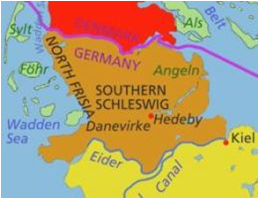The border between Schleswig-Holstein (Germany) and Denmark is hardly noticeable: many people speak both German and Danish. According to estimations, there are around 50 000 people who belong to the Danish minority, and who have German citizenship. They are well organised and form a bridge between the two neighbours Germany and Denmark.
The Danish minority in Germany lives in Southern  Schleswig, which is the northern part of the land of Schleswig-Holstein. They live in the city of Flensburg, the districts of Nordfriesland and Schleswig-Flensburg and in the northern part of the district of Rendsburg-Eckernförde. Southern Schleswig lies between the river Eider and the Kiel Canal in the south and the German-Danish border in the north; from the North Sea in the west to the Baltic Sea in the east (see map).
Schleswig, which is the northern part of the land of Schleswig-Holstein. They live in the city of Flensburg, the districts of Nordfriesland and Schleswig-Flensburg and in the northern part of the district of Rendsburg-Eckernförde. Southern Schleswig lies between the river Eider and the Kiel Canal in the south and the German-Danish border in the north; from the North Sea in the west to the Baltic Sea in the east (see map).
The percentage of members of the Danish minority as a proportion of the total population of specific municipalities varies very much and ranges from municipalities with only few families to about 20% in the city of Flensburg and in some small villages. The vast majority of the members of the Danish minority understand and speak Danish. The regular use and promotion of the Danish language is the basis for all the minority activities.
History
An uprising of the people of Schleswig-Holstein in 1848 against Denmark led in 1864 to a war between Denmark against Prussia and Austria. Since 1864 – after Denmark lost the war and Northern and Southern Schleswig were assigned to Prussia – there is an autochthonous Danish minority in Southern Schleswig (see also: Battle of Dybbøl).
In the plebiscite of 1920 Northern Schleswig (the area of the former county of Sønderjylland) voted for Denmark, whereas Southern Schleswig in majority voted for Germany. Since that time the Danish minority exists as a recognised minority, with Denmark as their motherland. Since the plebiscite of 1920 and the new border that resulted from it, there is a minority on both sides of the border.
In the period of National Socialist between 1933 and 1945 the Danish minority was victim to repressive measures, but they did not suffer from persecution like e.g. the minority of the Sinti and Roma did. On the other hand the members of the minorities were the only citizens of the Reich who were exempted from compulsory participation in the Nazi-organisations.
The first years after the war the associations of the Danish minority were immensely popular. Two years after the war already approximately 100 000 people identified with the minority. Also the number of kindergartens and schools increased rapidly. Refugees led to a strong growth of the Danish movement. People spoke of the “New-Danish movement”. Among the “New Danes”, there were also many people who were not familiar with the Danish culture and language. They hoped and asked for a secession of Southern Schleswig from Germany and union with Denmark. Once the refugee problem in Schleswig-Holstein was solved, also the growth of the Danish minority waned. Furthermore, it became clear that Denmark was not interested in changing the borders, as the Danish minority requested, and that Denmark also never had asked for such a change.
The atmosphere in the border region has been tense for a long time. Only in the run-up to the NATO-accession of Germany the situation fundamentally changed. In the run-up of accession by Germany, Denmark wanted to solve the minority issues in the border region as well. This succeeded in the end on 29 March 1955 and this resulted in the Bonn-Copenhagen Declarations, which are two parallel declarations that confirm the rights of persons belonging to the minorities in Northern and Southern Schleswig. Nowadays people describe the developments in the border region from “against one another” to “with one another” and “for one another”: these are important steps towards equality once and for all and an expression of good neighbourly relations in the border region.
- History (additional information): http://www.grænseforeningen.dk/, http://www.geschichte-s-h.de/vonabisz/daenischeminderheit.htm#top
The Danish language
The Danish language is one of the Germanic languages of the Indo-European language family and belongs to the sub-group of Scandinavian (North Germanic) languages. Together with Swedish it forms the East Scandinavian branch.
Thraces of the influence of the Nordic languages can be found in English nowadays, in words such as for example sky (Danish sky), law (Danish lov), window (Danish vindue) or the pronouns they, them, their (Danish de, dem, deres). The geographic proximity to Germany continuously influenced the Danish language, because many words were developed from the day-to-day cross-border contacts.
A specific feature of Danish is that it has many dialects, which even for mother-tongue speakers of Danish can be difficult to understand. The Southern dialect of Jutland is called Sønderjysk. This dialect was originally spoken in the area of the current minority, but was superseded from the Middle Ages onward by Low German. Today Sønderjysk is still widely spoken in the southernmost part of Denmark, which borders on Southern Schleswig, but in Southern Schleswig itself there are only few speakers left.
There are also so-called mixed languages, like for example a multi-ethnolect, which is spoken by some members of the Danish minority. This originates from directly translating from German into Danish without changing the syntax, from using germanisms and a German (relatively hard) pronunciation of Danish words. By the members of the minority this language is called Sydslesvigsk (Südschleswigsch in German) and regarded as a Danish dialect of its own.
Do you want to know more?
The language diversity team in the German-Danish border region
